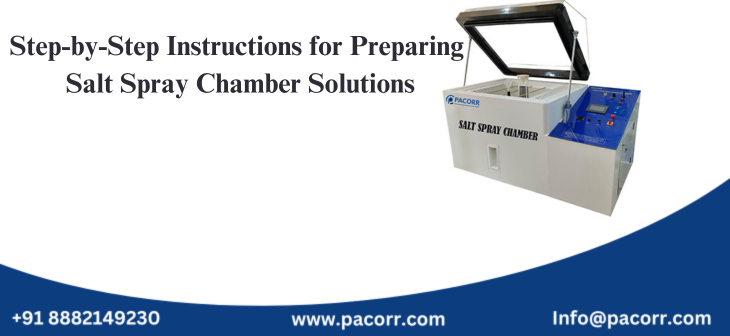
The Salt Spray Chamber, a cornerstone in corrosion resistance testing, demands meticulous preparation of its salt spray solution to ensure precise and consistent test outcomes. This blog serves as an in-depth guide on how to accurately concoct this vital solution, preserving the integrity of your corrosion tests and helping predict the longevity of both coated and uncoated materials under harsh environmental conditions.
Understanding Salt Spray Testing
Salt spray testing, or salt fog testing, is a standardized and popular method to assess the corrosion resistance of materials and surface coatings. It exposes test specimens to a highly corrosive environment of saltwater spray, which accelerates the corrosion process and helps predict the life span of materials under similar conditions.
Components of the Salt Spray Solution
The solution used in salt spray testing is not merely saltwater but a carefully prepared mixture that mimics the ocean's corrosive environment. The primary components include:
- Sodium Chloride (NaCl): Pure, reagent-grade sodium chloride is used to avoid any contaminants that might skew test results.
- Water: Deionized water is essential to ensure no additional minerals or chemicals interfere with the testing.
- pH Adjusters (Optional): Depending on the specific requirements of the test standard, hydrochloric acid (HCl) may be used to adjust the pH of the solution.
Step-by-Step Guide to Preparing the Solution of Salt Spray Test
1. Selecting the Right Salt
Use only high-purity sodium chloride - common table salt contains anti-caking agents and other impurities that can affect the outcome. Typically, the salt should have a purity of 99% or higher.
2. Measuring the Salt
The concentration of the salt solution usually ranges between 3% and 5% by weight, depending on the test standard (ASTM B117, ISO 9227). For a 5% solution, you would dissolve 50 grams of sodium chloride in every liter of deionized water.
3. Dissolving the Salt
Add the measured salt to deionized water in a clean container. Stir the mixture until the salt is completely dissolved. This process may take several minutes, and it's essential to ensure no undissolved granules remain.
4. Adjusting the pH
The pH of the solution should be monitored and adjusted according to the testing standard. For ASTM B117, the pH should be maintained within the range of 6.5 to 7.2. If necessary, slowly add dilute hydrochloric acid to lower the pH to the desired level.
5. Transferring the Solution
Once the solution reaches the desired concentration and pH, transfer it to the salt spray chamber's reservoir. Ensure that the solution is filtered to remove any undissolved particles or sediment that could clog the spray nozzles.
6. Maintaining the Solution
Regular checks and adjustments to the solution's concentration and pH are necessary throughout the test duration. Evaporation can concentrate the salt solution, so periodic dilution with deionized water may be required.
Tips for Ensuring Accurate Testing
- Regular Calibration: Regularly calibrate your equipment, including the pH meter and the balance used for weighing salt.
- Avoid Contamination: Always use clean, uncontaminated equipment for preparing and handling the salt spray solution.
- Consistent Temperature: Maintain a consistent temperature in the testing chamber as recommended by the standard (usually about 35°C).
- Record Keeping: Keep detailed records of the preparation and maintenance of the salt spray solution to ensure repeatability and traceability of the test results.
The preparation of the salt spray solution is as crucial as the testing procedure itself. Adhering to the guidelines and maintaining strict quality control over the solution preparation will lead to more reliable, consistent, and reproducible results in corrosion resistance testing. Educating yourself and your team on these best practices is vital for achieving the integrity and longevity of your materials in corrosive environments.
Thanks to Pacorr Testing instruments, we have all the required quality testing instruments that have helped us to ensure the best quality delivered to our clients.

Danish
Fair Exports Pvt. Ltd.

